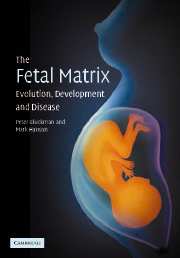Book contents
- Frontmatter
- Contents
- Preface
- 1 Shaping our destiny: genes, environment and their interactions
- 2 Mother and fetus
- 3 Fetal choices
- 4 Predictive adaptive responses and human disease
- 5 Obesity, diabetes and other diseases
- 6 The biology of predictive adaptive responses
- 7 Predictive adaptive responses – critical processes in evolution
- 8 Evolutionary echoes and the human camel
- 9 Improving human health
- 10 Fetal futures
- Further reading and references
- Index
7 - Predictive adaptive responses – critical processes in evolution
Published online by Cambridge University Press: 05 November 2011
- Frontmatter
- Contents
- Preface
- 1 Shaping our destiny: genes, environment and their interactions
- 2 Mother and fetus
- 3 Fetal choices
- 4 Predictive adaptive responses and human disease
- 5 Obesity, diabetes and other diseases
- 6 The biology of predictive adaptive responses
- 7 Predictive adaptive responses – critical processes in evolution
- 8 Evolutionary echoes and the human camel
- 9 Improving human health
- 10 Fetal futures
- Further reading and references
- Index
Summary
Our theory of predictive adaptive responses
We have introduced the term predictive adaptive responses by implication rather than by definition. It is now useful to define them more formally. We propose PARs as biological processes with the following characteristics:
They are induced by environmental factors acting in early life, most often in pre-embryonic, embryonic or fetal life, not as an immediate physiological adaptation, but as a predictive response in expectation of some future environment.
They are manifest in permanent change in the physiology or structure of the organism.
There are multiple pathways to the induction of these responses, involving different environmental cues acting at different times in development.
PARs are not restricted in direction, and occur across the full range of fetal environments.
The induction of PARs will confer a survival advantage in the predicted reproductive environment (that is appropriate prediction) and this will be manifest as increased fitness.
The PAR thus defines an environmental range in which the organism can optimally thrive until and through the reproductive phase of its postnatal life.
However, these PARs may well lead to disease or disadvantage when the predicted reproductive or post-reproductive environmental boundaries are exceeded (that is inappropriate prediction).
The first three criteria in this list have been well described in the previous chapters and will not be discussed further. The remainder of these criteria will be covered in this chapter, and we also speculate on two further potential characteristics.
PARs are likely to be neo-Darwinian adaptations permitting a species to survive short-term environmental challenges while preserving maximum genotypic variation for later environmental challenges and evolutionary fitness.
[…]
- Type
- Chapter
- Information
- The Fetal Matrix: Evolution, Development and Disease , pp. 144 - 172Publisher: Cambridge University PressPrint publication year: 2004



